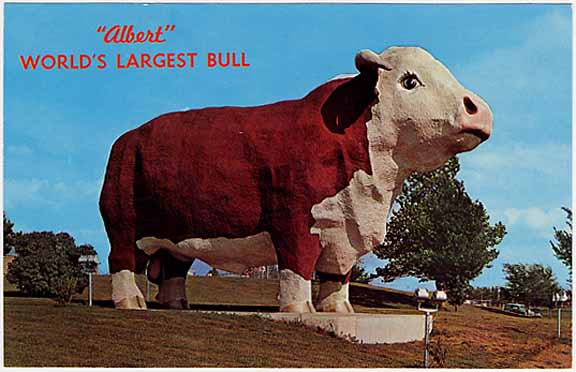
Albert the Bull Fact Sheet

From the Chamber of Commerce fact sheet:
WELCOME TO AUDUBON... HOME OF ALBERT THE BULL!
Here in the heart of T-Bone Country, famed for its livestock production and "Operation T-Bone", stands a gigantic tribute to the nation's beef industry. The statue, built by the Audubon Junior Chamber of Commerce, is a replica of a Hereford Bull - named "Albert".
The story of Albert dates back to the early 1950's when local cattle shippers were feeding great numbers of catttle to the prime grade and the best market was in Chcago. Cattle were shipped to market via railroad. Local shippers invited banker Albert (Al) Kruse of First State Bank (now Audubon State Bank) to ride with them but he declined after hearing others tell how drafty and uncomfortable the caboose ride could be on a cold late-fall, early-winter day. But he told them if and when they had a pullman car available on the cattle train, he would be happy to accompany them to the Chicago market. Finally, arrangements were made for the pullman car and soon a trainload of cattle and a pullman car full of shippers and businessmen were signed up for the trip to Chicago. Thus, the first Operation T-Bone was celebrated in 1951.
Operation T-Bone caused more of a stir than was ever thought possible. The Northwestern Railroad, Union Stockyards and Chicago Tribune as well as the London Times all did their share to spread the word about Operation T-Bone. Several changes have occurred over the years, but Operation T-Bone is still celebrated each year in early September.
The idea of "Albert" was conceived in 1961, but for lack of encouragement, dropped at that time. In 1963 a chapter of the Junior Chamber of Commerce was organized in Audubon. The plan for Albert was presented to them with the idea that it could be merged with Operation T-Bone to promote the beef industry as a vital factor to the economy of Iowa and the nation. At the same time the huge critter would serve as a much needed tourist attraction for the area.
The Junior Chamber of Commerce, "Jaycees", overwhelmingly approved the idea. The 108 member group anxiously anticipated the challenge of building "the biggest bull in the world." In choosing a name for the bull it seemed only fitting to name him "Albert" after Albert Kruse who originated Operation T-Bone.
There was one major stipulation in the Jaycee resolution to sponsor the project; that no solicitation of funds be made in the community. The project costs, estimated at $30,000, were financed through various fund-raising activities and donations from agricultural industries across the nation. One of the biggest boosts came from the American Hereford Association which pledged cash and technical assistance. To keep expenses down, the Jaycees scoured the countryside for abandoned windmills and other steel equipment that could be converted into reinforcing material for the platform.
When the platform was completed a rectangular I-Beam structure, the stateue's "skeleton" was erected over the platform. The "hide" was constructed over the winter months at the Emmert Manufacturing Company in Audubon. The Emmert Company and Jaycee volunteers welded and shaped quarter-inch steel rods into four sections that were fitted over the I-Beam structure. The framework was pieced together much like the construction of a model airplane. The framework was then covered with heavy wire meshing as a base for the concrete "coat" of the statue.
At this point, the four sections were trucked to the statue site. With most of the Jaycee membership and a flock of townspeople looking on with some apprehension, a giant crane hoisted the sections on to the I-Beam structure. They slid together without a hitch and the labyrinth of rods and wire indeed resembled a mighty big bull!
The first coat of concrete was hand troweled by the Jaycees and volunteers of Schmidt Construction Company with the second and third coats applied with a hose. The inside of the statue also received a coat of concrete. By spraying cement over the metal lathe the Jaycees were able to give thestatue's hide a hairlike texture. The painting was completed by Cam Ross Sign Company. It took 65 gallons of paint to cover Albert with the red and white colors of the Hereford breed. The 45 ton statue is authentic right down to his toenails. Albert has a horn span of 15 feet and towers 30 feet above the landscape - making him visible day and night from Highway 71 at the south edge of Audubon, Iowa.
Thousands of tourists enjoy visiting Albert the Bull each year.
From the info sheet captions:
The concrete pad on which "Albert" stands was the first step in the construction of the Audubon Jaycees' monument to the Beef industry.
The interior framework of "Albert" consists of many sections similar to the one displayed here. The steel-rod sections were put together much as you'd build a model airplane.
This view shows the rectangular I-Beam structure which serves as the main interior support, or "skeleton", of the 45-ton monument. Note how the steel-rod framework was fitted to the I-Beam structure.
Albert's hide sonsists of several coats of concrete. The first coat was applied by trowels to a wire meshing covering the steel rod framework.